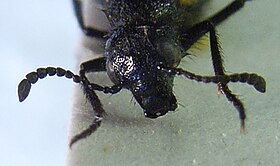Pannonian oil beetle
| Pannonian oil beetle | ||||||||||||
|---|---|---|---|---|---|---|---|---|---|---|---|---|

Pannonian oil beetle ( Mylabris pannonica ) |
||||||||||||
| Systematics | ||||||||||||
|
||||||||||||
| Scientific name | ||||||||||||
| Mylabris pannonica | ||||||||||||
| Kaszab , 1956 |
The Pannonian oil beetle ( Mylabris pannonica ) is a beetle from the oil beetle family . (Meloidae). The generic name Mylabris was given to an insect in ancient Greece that is found by bakers and millers. The species name pannōnica refers to the Pannonia landscape , where the beetle is mainly found.
The genus Mylabris is represented in Europe with seven subgenera, the Pannonian oil beetle belongs to the subgenus Micrabis .
Characteristics of the beetle

|
| Image 1: head from the front |

|
| Image 2: side view |
The beetles are 6 to 12 millimeters long. The body is elongated and cylindrical.
The legs are thin, all splints have two end spines. The peg-shaped front hips touch. The hind legs each have only four tarsi, the other tarsi are five-limbed (family series Heteromera ). The claws are split into two unequal, not serrated halves.
The broad head is suddenly constricted at the back and connected to the pronotum by a narrow neck. This is a little narrower than the head and significantly narrower than the elytra . It is parallel and widest in the middle. The clypeus is delimited from the forehead by a clear seam (Fig. 1). The short antennae are eleven-limbed and string-shaped. They are inserted at the front edge of the eyes in their faint border. All the antennae are clearly separated from one another, they gradually increase in length and thickness. The penultimate antennae segment is also longer than it is wide, the last is conically pointed, twice as long as it is wide in the males, and slightly shorter in the females.
The elytra are only slightly hardened and completely cover the abdomen. At the back they can gape a little. The drawing of the wing covers varies greatly, whereby the yellow-brown or black color can predominate. The genus Mylabris has five species in Central Europe. Despite the large aberration spectra of these species, they can be distinguished from one another by the drawing of the wings. M. pannonica has - like two other species - a yellow spot in the black end of the wing, which is bordered in black at least towards the back. On the folded down sides at the base of the wing covers it has (like M. tenera ) a yellow spot (picture 2). In contrast to M. tenera , however, the elytra are shiny because they are not very finely grooved (chagriert). The back part is pointed and narrow and is colored black.
Way of life
The larvae are parasitic and parasitic on bees. The first larval stage ( Triungulinus ) is six-legged and mobile. The later larval stages are thick, soft, membranous, walnut and footless. The beetles are found on flowers. The species is forex and thermophilic .
Occurrence
The animals occur frequently in the Mediterranean area up to the Pannonian Danube basin to Hungary and the Czech Republic . They fly from June to September.
literature
- Heiko Bellmann : The New Cosmos Insect Guide , Franckh-Kosmos Verlags-GmbH & Co, Stuttgart 1999, ISBN 3-440-07682-2
- Heinz joy , Karl Wilhelm Harde , Gustav Adolf Lohse (ed.): The beetles of Central Europe . tape 8 . Teredilia Heteromera Lamellicornia . Elsevier, Spektrum, Akademischer Verlag, Munich 1969, ISBN 3-8274-0682-X .
- G. Jäger (Ed.): CG Calwer 's Käferbuch . K. Thienemanns, Stuttgart 1876, 3rd edition
Web links
- Mylabris (Micrabris) pannonica at Fauna Europaea
Individual evidence
- ↑ Sigmund Schenkling: Explanation of the scientific beetle names (genus)
- ↑ Sigmund Schenkling: Explanation of the scientific beetle names (species)
- ↑ Mylabris at Fauna Europaea. Retrieved November 25, 2012
- ↑ Mylabris pannonica in Fauna Europaea. Retrieved November 25, 2012